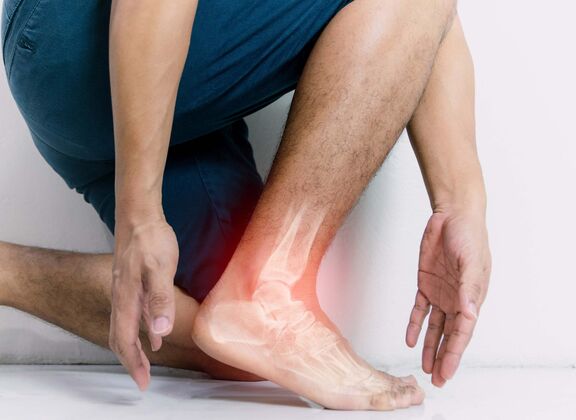Nonsteroidal anti-inflammatory medications, ice, physical therapy, supportive taping and bracing, or orthotic devices are the common ways of treating painful progressive flatfoot. Contact your physician before taking any medication. In some cases, a surgical operation may need to be performed to repair the torn or damaged tendon and restore normal function. To prevent reinjury, orthotic devices may be recommended. In severe cases, surgery on the midfoot bones may be necessary to treat the associated flatfoot condition.
Metatarsalgia (foot pain in ball)
Foot pain in the “ball of your foot,” the area between your arch and the toes, is generally called metatarsalgia. The pain usually centers on one or more of the five bones (metatarsals) in this mid-portion of the foot.
Also known as “dropped metatarsal heads,” metatarsalgia can cause abnormal weight distribution due to over-pronation.
Metatarsalgia causes one of metatarsal joints to become painful or inflamed. People often develop a callus under the affected joint. Metatarsalgia can also be caused by arthritis, foot injury (sports, car accidents, repeated stress), hard surfaces (cement or tile floors) and specific footwear (rigid soled work boots). Inappropriate shoes will only aggravate the condition.
A simple change of shoes may solve the problem. In more severe cases, full-length custom-molded foot inserts may need to be prescribed.
Plantar Fibromas (lumps in the arch of the foot)
A plantar fibroma is a benign tissue tumor or growth on the plantar, or bottom surface of the foot. Unlike plantar warts, which grow on the skin, these grow deep inside on a thick fibrous band called the plantar fascia. Non-surgical measures for treating plantar fibromas, such as orthotics, have failed to provide adequate relief of symptoms. Surgical correction can lead to further complications such as plantar nerve entrapment and larger and recurrent fibromas often worse than the original problem.
The CRYOSTAR Cryoanalgesia procedure has been shown to shrink these fibromas with the use of extreme cold technology. The fibromas treated to date have decreased in size, become softer, and much less painful. This 7 minute treatment causes minimal to no post operative disability and patients can return to regular shoe gear with 24-48 hours after cryosurgery.
Sesamoiditis
There are a few bones in the human body that are connected only to tendons or are embedded in muscle. These are the sesamoids. Two very small sesamoids (about the size of a kernel of corn) are found in the underside of the forefoot near the great toe – one on the outer side of the foot and the other closer to the middle of the foot.
Sesamoids provide a smooth surface over which the tendons slide, thus increasing the ability of the tendons to transmit muscle forces. The sesamoids in the forefoot also assist with weight-bearing and help elevate the bones of the great toe. Like other bones, sesamoids can fracture. Additionally, the tendons surrounding the sesamoids can become irritated or inflamed. This is called sesamoiditis and is a form of tendonitis, and is common among ballet dancers, runners and baseball catchers.
SYMPTOMS INCLUDE:
- Pain under the big toe or on the ball of the foot
- Swelling and bruising
- Difficulty and pain in bending and straightening the big toe
Surgery is usually not required to treat sesamoiditis. Over-the-counter anti-inflammatory medications, as well as rest and ice the sole of your feet, usually relieve the pain. Consult your physician before taking any medications.

